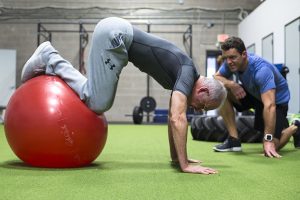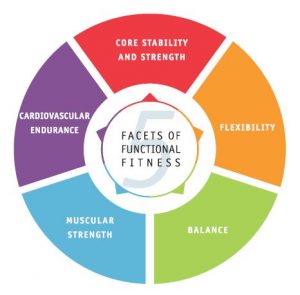 My last post discussed how functional fitness helps you put the brakes on aging. It’s a holistic approach with five dimensions. And to fight off old age effectively, you need to train for them all.
My last post discussed how functional fitness helps you put the brakes on aging. It’s a holistic approach with five dimensions. And to fight off old age effectively, you need to train for them all.
So what exactly do you need to do? There’s no one “right” answer. The best fitness program is one that fits your fitness goals, is sustainable and, ideally, includes activities you might even enjoy! You can join a gym or not, exercise at home or outdoors, work out solo or in groups. It’s all up to you.
What’s more, functional fitness doesn’t have to be a schedule-buster. There are plenty of ways to train in two or more dimensions at once. For example, yoga isn’t just for flexibility; depending on the style and instructor, it can also improve balance and strength. You can even target four or five dimensions at once with circuit training classes or old-fashioned calisthenics. And don’t forget opportunities to be active while doing gardening or other chores around the house.
Here are some ideas for devising a functional fitness plan that works for you:
Core strength – Concentrate on whole body exercises that can be adapted to almost any fitness level: the plank, the squat, and versions of the push-up.
Flexibility – Stretch regularly, if not daily, at home or in a gym. Do dynamic stretches before being active and as you feel tight. Attend yoga or Pilates classes. Use a foam roller to help loosen areas of tightness. Find opportunities to fully extend your movements as you go about your daily tasks.
Balance – Work simple balance exercises into your day, like standing on one foot while you brush your teeth. Practice walking heel-to-toe with one foot directly in front of the other. Take up tai chi or yoga. Building core and lower body strength will also help reduce your risks of a serious fall.
Muscular strength – Do two or three strength-training workouts a week, focusing on basic push, pull, and hip-hinge or squat exercises. For an efficient gym workout, rely on whole-body exercises using your body weight and/or free weights, rather than muscle-isolating machines. Outside the gym you can use resistance bands, free weights, or your body weight. If you’re new to strength training, see my article on how to get started.
Cardiovascular endurance – Get at least 30 minutes of vigorous cardio exercise three times a week (or five weekly sessions of more moderate exercise). This need not be on cardio machines. There’s also brisk walking, swimming, biking, rowing, stairclimbing, aerobic dance – you name it, as long as it keeps you moving.
In next week’s post we’ll talk about how to enhance your program’s results and set yourself up for success.